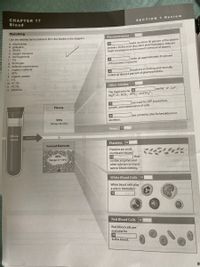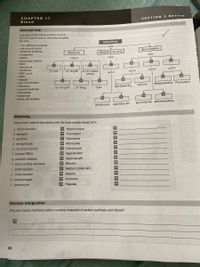
Human Anatomy & Physiology (11th Edition)
11th Edition
ISBN: 9780134580999
Author: Elaine N. Marieb, Katja N. Hoehn
Publisher: PEARSON
expand_more
expand_more
format_list_bulleted
Question

Transcribed Image Text:CHAPTER 17
Blood
SECTION 1 Review
Matching
Plasma Proteins 1
Use the lettered terms below to fill in the blanks in the diagram.
a. electrolytes
b. globulins
C. 99.9%
d. oxygen transport
e. cell fragments
f. 7%
g. fibrinogen
h. defense mechanisms
i. organic nutrients
i. 92%
k. organic wastes
I. 1%
m. <0.1%
2
Imake up about 60 percent of the plasma
proteins. As the most abundant plasma proteins, they are
major contributors to the osmotic pressure of plasma.
3
of the proteins in plasma.
Imake up approximately 35 percent
functions in clotting and normally
4|
makes up about 4 percent of plasma proteins.
n. <0.1%
o. albumins
5.
Other Solutes
are Nat, K*, Ca2+,
The major plasma 6
Mg2+, Cl-, HCO,", HPO,", and SO,2.
are used for ATP production,
Plasma
growth, and maintenance of cells.
CH lamionds
8
are carried to sites for breakdown or
55%
excretion.
(Range 46-63%)
Water 9
Whole
consists of
blood
Platelets 1o
Formed Elements
Platelets are small,
membrane-bound
45%
that
11
contain enzymes and
other substances impor-
tant to blood clotting.
(Range 37-54%6)
White Blood Cells 12
White blood cells play
a role in the body's
13
Red Blood Cells 14
Red blood cells are
essential for
15
in the blood,
89

Transcribed Image Text:CHAPTER 17
SECTION 2 Review
Blood
Concept map
Use each of the following terms once to
fill in the blank boxes to correctly complete
the map.
Hematology
• iron-deficiency anemia
• reticulocyte count
• lymphoid leukemia
• congenital
• sepsis
• pernicious anemia
• MCV
• hematocrit
• nutritional
• RBC count
• MCH
• malaria
• Hb concentration
• infections
• myeloid leukemia
• hemophilia
• leukemias
• sickle cell disease
studies
Blood disorders
Blood tests
Blood-forming tissue
types
cancer
measure
11
12
10
such as
such as
37-54%
12-18 g/dL
such as
4.2-6.3 million
cells/ul
such as
18
14
13
"blood poisoning" Plasmodium
lack iron
82-101 um3
lack vitamin B12
27-34 ug
0.8%
16
15
bris o
abnormal Hb abnormal dotting
granulocytes agranulocytes
Matching
Match each lettered description with the most closely related term.
19
19 Myeloid tissue
20 Anucleated
a. blood disorders
20
b. basophil
21
21 Dyscrasias
22 Monocytes
23 Granulocyte
24 Agglutination
25 Agranulocyte
c. jaundice
d. venipuncture
22
23
e. red bone marrow
24
f. mature RBCS
25
g. parasitic disease
h. blood clotting elements
26 Bilirubin
26
i. erythropoietin
27 Median cubital vein
27
j. cross-reaction
28 Malaria
28
29 Hormone
29
k. macrophages
30 Platelets
30
I. lymphocyte
Section integration
Why are mature red blood cells in humans incapable of protein synthesis and mitosis?
31
90
Expert Solution
This question has been solved!
Explore an expertly crafted, step-by-step solution for a thorough understanding of key concepts.
This is a popular solution
Trending nowThis is a popular solution!
Step by stepSolved in 2 steps

Knowledge Booster
Similar questions
- 6 of 20 Plasma albumins primarily function in the body's defence transport certain proteins in the blood transport iron in the blood contribute to the clotting process maintain the blood's osmotic pressurearrow_forwardExplain the steps of renin conversion to angiotensin II that take place once renin is secreted into the blood. Be specific and don’t use abbreviationsarrow_forwardMost dissolved Substances in blood plasma Can Mave out of the blood Stream casily and into interstitial Flvid Surrour counding there is a decrease the Cells. IF in 'saltiness'" what to the interstitial Fluid? happens witharrow_forward
- choice all that applies. Ideally, increased osmotic pressure in the plasma will result to:a. increased arterial hydrostatic pressure c. increased water reabsorption in the tubulesb. increased glomerular filtration rate d. increase in interstitial colloid osmotic pressure e. none of the abovearrow_forwardPlease help me answer question 3arrow_forwardA patient (76 years old female) with compromised cardiac function was hospitalized due to significant volume overload and generalized edema. Chest X-ray confirmed pulmonary edema, ejection fraction was estimated - 20%. Patients’ heart rate and blood pressure have been monitored. Despite intravenous use of diuretics she still feels significant shortness of breath, her blood pressure is now 90/60 mm Hg. Blood tests confirmed that renal function is worsening. Blood creatinine – 2.0 mg/L, Na – 132 mEq/L; K – 3.9 mEq/L. Intravenous therapy with Dobutamine was initiated. Questions: What group of cardiovascular drugs does dobutamine belong to? What is mechanism of action? What effect this drug has on cardiac and vascular adrenergic receptors?arrow_forward
arrow_back_ios
SEE MORE QUESTIONS
arrow_forward_ios
Recommended textbooks for you
 Human Anatomy & Physiology (11th Edition)Anatomy and PhysiologyISBN:9780134580999Author:Elaine N. Marieb, Katja N. HoehnPublisher:PEARSON
Human Anatomy & Physiology (11th Edition)Anatomy and PhysiologyISBN:9780134580999Author:Elaine N. Marieb, Katja N. HoehnPublisher:PEARSON Anatomy & PhysiologyAnatomy and PhysiologyISBN:9781259398629Author:McKinley, Michael P., O'loughlin, Valerie Dean, Bidle, Theresa StouterPublisher:Mcgraw Hill Education,
Anatomy & PhysiologyAnatomy and PhysiologyISBN:9781259398629Author:McKinley, Michael P., O'loughlin, Valerie Dean, Bidle, Theresa StouterPublisher:Mcgraw Hill Education, Human AnatomyAnatomy and PhysiologyISBN:9780135168059Author:Marieb, Elaine Nicpon, Brady, Patricia, Mallatt, JonPublisher:Pearson Education, Inc.,
Human AnatomyAnatomy and PhysiologyISBN:9780135168059Author:Marieb, Elaine Nicpon, Brady, Patricia, Mallatt, JonPublisher:Pearson Education, Inc., Anatomy & Physiology: An Integrative ApproachAnatomy and PhysiologyISBN:9780078024283Author:Michael McKinley Dr., Valerie O'Loughlin, Theresa BidlePublisher:McGraw-Hill Education
Anatomy & Physiology: An Integrative ApproachAnatomy and PhysiologyISBN:9780078024283Author:Michael McKinley Dr., Valerie O'Loughlin, Theresa BidlePublisher:McGraw-Hill Education Human Anatomy & Physiology (Marieb, Human Anatomy...Anatomy and PhysiologyISBN:9780321927040Author:Elaine N. Marieb, Katja HoehnPublisher:PEARSON
Human Anatomy & Physiology (Marieb, Human Anatomy...Anatomy and PhysiologyISBN:9780321927040Author:Elaine N. Marieb, Katja HoehnPublisher:PEARSON

Human Anatomy & Physiology (11th Edition)
Anatomy and Physiology
ISBN:9780134580999
Author:Elaine N. Marieb, Katja N. Hoehn
Publisher:PEARSON

Anatomy & Physiology
Anatomy and Physiology
ISBN:9781259398629
Author:McKinley, Michael P., O'loughlin, Valerie Dean, Bidle, Theresa Stouter
Publisher:Mcgraw Hill Education,

Human Anatomy
Anatomy and Physiology
ISBN:9780135168059
Author:Marieb, Elaine Nicpon, Brady, Patricia, Mallatt, Jon
Publisher:Pearson Education, Inc.,

Anatomy & Physiology: An Integrative Approach
Anatomy and Physiology
ISBN:9780078024283
Author:Michael McKinley Dr., Valerie O'Loughlin, Theresa Bidle
Publisher:McGraw-Hill Education

Human Anatomy & Physiology (Marieb, Human Anatomy...
Anatomy and Physiology
ISBN:9780321927040
Author:Elaine N. Marieb, Katja Hoehn
Publisher:PEARSON